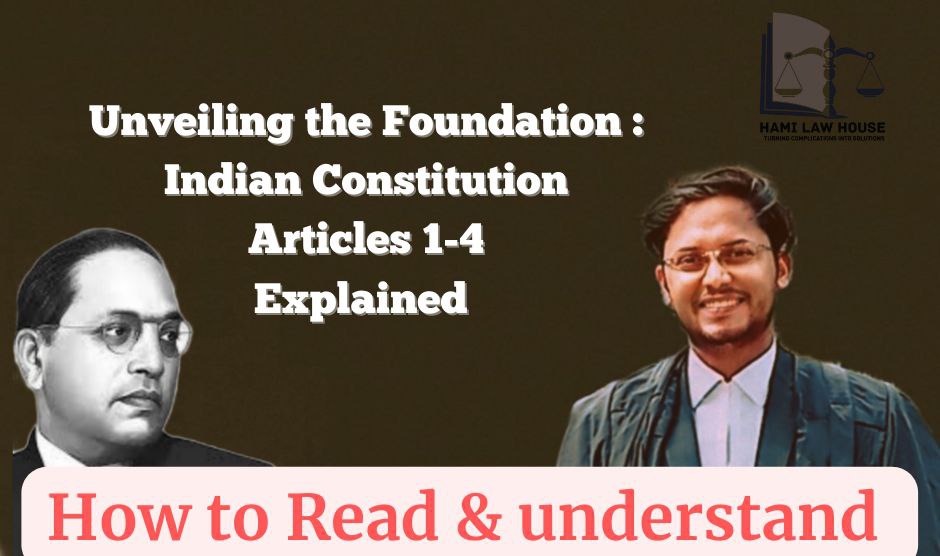New Delhi: Indian Constitution Articles 1 and 4 Unraveling the Essence of Union: Reading and understanding the Indian Constitution can be a rewarding but challenging task due to its comprehensive nature. Here are some steps to help you approach it effectively:
- Read the Preamble: Start by reading the Preamble, which outlines the guiding principles and objectives of the Constitution. It will give you a broad idea of the values and aspirations on which the Constitution is based.
- Take it in sections: The Constitution is divided into articles and parts. Read it section by section or article by article to grasp the content in a more organized manner.
- Understand the structure: Familiarize yourself with the organization of the Constitution. It is divided into various parts, schedules, and amendments. Pay attention to the fundamental rights, directive principles, and fundamental duties, as these are essential components.
- Interpretation: Be mindful that the Constitution may contain legal and technical language. If you come across any complex terms or phrases, take the time to understand their meanings or seek help from legal dictionaries or commentaries.
- Refer to commentaries: There are various commentaries and guidebooks written by legal experts that can help in understanding the Constitution in simpler terms. You can use these resources to clarify any doubts you might have.
- Historical context: Understanding the historical context in which the Constitution was written can provide valuable insights. Study the debates of the Constituent Assembly to gain a deeper understanding of the framers’ intentions.
- Connect with real-life examples: Relate the constitutional provisions to real-life situations and cases. This will help you see how the Constitution applies to practical scenarios.
- Read landmark judgments: Reading landmark judgments of the Supreme Court related to constitutional matters can give you a better understanding of how the Constitution is interpreted and applied in various situations.
- Take your time: Reading and understanding the Constitution is not a task that can be completed in a short period. Take your time, read at your own pace, and don’t hesitate to revisit sections that you find challenging.
- Discuss with others: Engage in discussions with friends, peers, or online forums interested in constitutional matters. Sharing perspectives and insights can enhance your understanding.
Articles 1 to 4 of the Indian Constitution provide the basic framework and provisions related to the union and its territories. Let’s go through each article and explain them with examples:
-
Article 1: Name and territory of the Union
Article 1 states that India, that is Bharat, shall be a Union of States. It provides the name of the country and specifies its territorial extent. India is a federal country comprising states and union territories. For example, the state of Maharashtra, the state of Tamil Nadu, and the union territory of Delhi are all part of the Union of India as defined in Article 1.

-
Article 2: Admission or establishment of new states
Article 2 deals with the admission or establishment of new states within the Indian Union. It empowers the Parliament to admit new states into the Union or establish new states by separating territories from existing states. An example of this is the creation of Telangana as a separate state from the existing state of Andhra Pradesh in 2014. Through the passage of legislation, Telangana was established as the 29th state of India.

-
Article 3: Formation of new states and alteration of boundaries
Article 3 gives the power to the Parliament to form new states or alter the boundaries of existing states. This can be done through the enactment of a law passed by the Parliament. For example, the reorganization of states that took place in 1956 was done under Article 3. This reorganization led to the linguistic reorganization of states, where states were created or reconstituted based on linguistic lines. As a result, states like Andhra Pradesh, Maharashtra, and Gujarat were formed.

-
Article 4: Laws made under Articles 2 and 3 to provide for the amendment of the First and Fourth Schedules and supplemental, incidental, and consequential matters
Article 4 deals with the power of the Parliament to make laws amending the First and Fourth Schedules of the Constitution, which relate to the states and union territories. It also includes provisions for supplemental, incidental, and consequential matters related to the formation of new states or the alteration of boundaries. This article gives the Parliament the authority to make necessary changes to accommodate the creation or modification of states. An example would be when the Parliament amends the Fourth Schedule to include a new state or union territory, adjusting the representation and administration accordingly.

These articles collectively provide the legal framework for the formation, admission, and alteration of states and union territories within the Indian Union.
Join Our YouTube : Click Here

